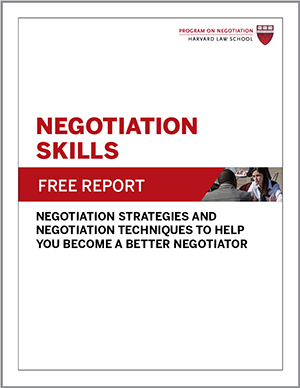
This past holiday season, you might have noticed that retailers were offering sales earlier than usual. That was indeed the case, according to Salesforce: Retail sales started ramping up in early November 2023, sooner than they did in 2022.
But are such sales truly sales? Often, the answer is no. Black Friday discounts and other hefty sales are often not deep concessions. Rather, many retailers engage in price anchoring, which Shopify defines as “the practice of establishing a reference price to influence consumers’ perception of a product’s value and guide their purchasing decisions.”
Price anchoring draws on knowledge of the anchoring bias, or anchoring heuristic, a common decision-making shortcut that can lead us astray in purchasing, negotiation, and other realms.
What is price anchoring?
In price anchoring, retailers “mark up the prices and then offer seemingly deep discounts to make the deals look more attractive,” University of Maryland marketing professor Jie Zhang told the Washington Post. The Post explains: “This usually involves a retailer raising the price on a particular item—say a flat-screen TV—for a short period, only to mark it down to the original price while marketing it as a limited-time, steep discount.” Or the retailer might never actually sell the item at its “full price” at all.
Price anchoring has proven to be an effective means of convincing consumers to part with their money. It capitalizes on the anchoring bias, a phenomenon first documented by psychologists Amos Tversky and Daniel Kahneman. In their experiments, the researchers found that people who were asked to make numerical estimates were highly influenced by arbitrary numbers. For example, in one study, participants were asked to estimate the percentage of African countries in the United Nations. They then observed the spin of a wheel of fortune, which landed on either 10 or 65. The participants were “anchored”: Those who saw a 10 made significantly lower estimates than those who had seen a 65.
“In many situations, people make estimates by starting from an initial value that is adjusted to yield the final answer,” Tversky and Kahneman conclude. The anchoring bias is a common pitfall in purchasing and price negotiations.
In the retail context, price anchoring can make consumers feel a sense of urgency, as they assume (often falsely) a “deal” won’t last long. We might not need or even want the sale item, but buying it provides a temporary rush, a feeling of being a “smart shopper.”
Why price anchoring persists
Deceptive pricing is illegal in the United States, but rarely policed, despite running rampant. The nonprofit Consumers’ Checkbook tracked prices of certain items at 25 major retailers over 33 weeks in 2022 and found that at eight of the companies, more than half the items tracked were offered at false discounts every week or almost every week. The worst offenders included Foot Locker, Amazon, the Gap, Williams Sonoma, and Wayfair. At Foot Locker, the items tracked were “on sale” 98% of the time. Only two of the retailers studied, Apple and Costco, offered legitimate sales—genuine discounts from established prices.
JCPenney is often cited as a cautionary tale of what can happen to a retailer when it doesn’t play this game, Forbes reports. In 2011, the company’s new CEO, Ron Johnson, modeled the company’s stores on Apple, which included doing away with coupon discounts and instead advertising “everyday low prices.” Slumping sales followed. Johnson erred in assuming that Penney’s shoppers, like Apple’s, would head to its stores even without the lure of sales promotions. Johnson was soon out, and the old pricing strategy returned. In fact, JCPenney currently faces a class-action lawsuit in California for using “false reference pricing schemes,” reports the Post.
How to avoid the anchoring bias
Here are a few guidelines for avoiding the anchoring bias when shopping:
- Don’t just browse. Browsing from shop to shop (or website to website) leads to impulse purchases as we’re lured by false discounts. Before shopping, make a plan, focusing on what you actually need. If you’ll be shopping with someone, ask them to help you stay on track—rather than egging you to buy something you’ll later regret.
- Slow down. The anchoring effect, like other cognitive shortcuts, is most prevalent when we’re under time pressure and don’t have time to think deliberately. If you see what looks like a great deal, think about it for a day or two, perhaps in consultation with a family member or friend. If you decide to make a purchase, consider whether negotiating an even better price is a possibility (such as for an appliance or other big-ticket item).
- Compare across items. Price anchoring is effective because it narrows our focus to one particular item. It loses its power when consumers take the time to make price comparisons across comparable items. This is easy to practice at the grocery store, notes Shopify: Before grabbing the laundry detergent marked with an eye-catching “$2 off” shelf tag, compare its price per ounce (printed on the tag) to that of its competitors. The store brand could still turn out to be a better deal.
What strategies have you used to avoid falling victim to the anchoring bias in purchasing and negotiation?




